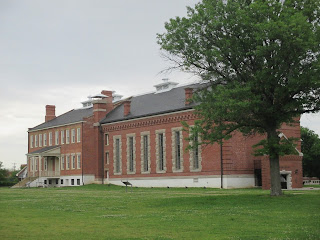 |
| Mt Magazine, Arkansas' High Point |
We camped the night somewhere off of a dirt road in the Ouachita National Forest on the lower slopes of Mt. Magazine. We had driven far on the prior day, and when we saw the dirt road turning of the pavement, we took it. It was a road just like any of the others, but since night was falling quickly, and it wasn't someone's driveway, it met our needs. We bumped across the ruts, easing our way onward, as we scouted out a few possible campsites, finally determining that the first one we had passed looked the best. I pulled the car forward and backward into a 10-15 point turn, finally succeeding in turning around and avoiding getting stuck in the thick undergrowth. I woke up a few times during the night, once to the soft patter of rain on the tent, another time to the harsh sound of a truck's engine brake is it descended the tight curves on the highway below us. I drifted back to sleep until the early morning glow of dawn dissipated the last chance for rest.
 |
| Mt Magazine Trailhead |
We packed up quickly, my wife and kids to avoid the rain that was once-again threatening, and me to stay warm in the crisp morning air. I'd successfully packed everything we needed for the trip, but we were several hours from home when I realized that I'd left my jacket on the couch in the living room. Oh well, I've concluded that you need to forget or leave something on every trip, this time I was the lucky one. Me without a jacket was much better then the time my brother left his shoes, or the time I forgot the bug spray. A chilly hour or so every morning was tolerable and I knew I could always be a little more active to ward off the chill. After we were all loaded, we drove up the road to Mt Magazine State Park, and found a pavilion we could cook breakfast under and stay out of the drizzle. After a warm bowl of oatmeal, and the happiness that comes from a full stomach, we packed up our cook stove, and went to the small museum at the entrance to Mt Magazine. It was a small museum with a large gift shop. We wandered the exhibits, grabbed a few maps and brochures, then drove up the road to find the high point of Arkansas.
 |
| What a view! |
There's a scenic drive, campground built by the CCC, an amphitheater, and a lodge and cabins at Mt Magazine, in addition to the hiking trails. We were out to climb the highest point in Arkansas, so as we drove around, we kept our eye out for the trailhead. We found the trailhead quite readily, but the parking was a wide spot across the road, along another road that came and t-boned with the main loop through the park. We drove on, and wound our way around Mt Magazine as we waited for a short break in the weather. Finally it looked like a clearing in the rain so we pulled in, loaded up, and set off on our hike.
 |
| Arrowheads at Mt Magazine State Park Museum |
There are three different trails that will lead to the top of Mt Magazine/ Signal Hill. Most commonly, the hike is completed as a loop hike, going counterclockwise from the trailhead. We rushed up the trail, noting that spring was several weeks behind the lower elevation trails we had been on earlier in the week. I thought it was about 2 weeks slower then the lower elevations, approximately one week for every thousand feet of elevation it was over the surrounding hills and valleys. After 15 minutes of hiking, with the kids hiking the trail under their own power and on their own short legs, we made it to the top. It's not a hard hike, and it's quite enjoyable. We'd been at the top for about 3 minutes when a kindergarten class started trooping in, out on a field trip. We quickly took our pictures, then stepped aside for the 5 year olds to gather into the clearing at the top of Arkansas. It was fun to see them out having a great time. Hats off to their teachers for taking them hiking! We turned around, and hiked back to the car, just a few moments before rain droplets started up again.
Nearest City:
Paris, AR
Location: 16878 AR-309, Paris, AR
Time Needed:
30+ min
Difficulty:
easy
Kid Friendly: yes
Additional Info: Arkansas State Park
Website












































